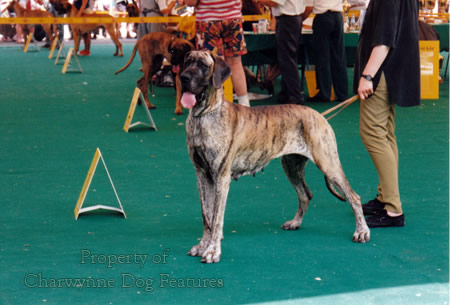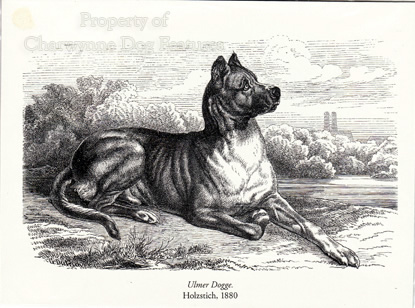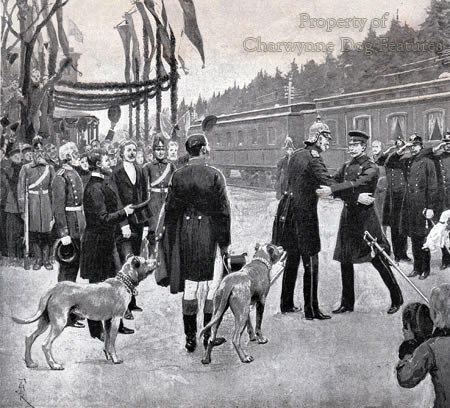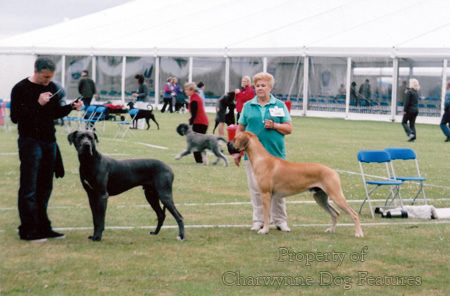726 Putting Dogs Before Breeds
PUTTING DOGS BEFORE BREEDS
by David Hancock
 A few years ago I was attending an agricultural show, chatting to a pony judge and a livestock breeder, when a visitor strolled past with his two huge Great Danes. All three of us, being interested in animals, paused to study them. When we looked back at each other the conclusion was mutual and painfully obvious: here were two anatomically seriously flawed four-legged animals, whatever their species. These two statuesque dogs were victims of their breed; although, victims of their breed fanciers would be more accurate. My colleagues turned to me, the member of the trio most interested in dogs, with the questions: Why do they (i.e. the breeders) do it? and Do they (the breeders) know what they are doing?
A few years ago I was attending an agricultural show, chatting to a pony judge and a livestock breeder, when a visitor strolled past with his two huge Great Danes. All three of us, being interested in animals, paused to study them. When we looked back at each other the conclusion was mutual and painfully obvious: here were two anatomically seriously flawed four-legged animals, whatever their species. These two statuesque dogs were victims of their breed; although, victims of their breed fanciers would be more accurate. My colleagues turned to me, the member of the trio most interested in dogs, with the questions: Why do they (i.e. the breeders) do it? and Do they (the breeders) know what they are doing?
It would be wrong however to pick out Great Dane breeders for scrutiny in answering those two key questions. At four World Dog Shows I have asked myself the same questions when viewing the Mastiff of my country being paraded around the show ring. Small dogs and heavily-coated dogs often get away with faulty construction but a huge dog, especially one with a short coat, displays every fault in anatomy revealingly. A small or lightly-built dog can also manage reasonably well with structural faults; a huge dog however has a reduced quality of life from significant physical shortcomings, mainly from the sheer weight borne by the skeleton.
When I was in farming I used to spend time studying our working shire horses, noting their shoulder placement, weight of bone, length of back and how they used their legs when used as draught animals. Their anatomical design came from their function; their great strength was needed to pull substantial weights, their movement had to be economical and their power geared to the ability to pull with the greatest efficiency. Dogs used as draught animals possess the same chunky build, as the handsome and admirable Bernese Mountain Dog demonstrates to this day. But it is a strange pursuit for breeders of dogs not developed to act as draught-dogs to desire massive bone in their breeds.
Both the Mastiff and the Great Dane, despite their current grouping by many kennel clubs, were heavy hounds. They were designed to hunt big game. Big game, such as wild boar, stag, bears, bison, aurochs and wild bulls, were fearsome adversaries. In some western European hunts more dogs died in the hunt than their quarry. There was a saying in medieval Germany that if you wanted boars' heads you had to sacrifice dogs' heads. The heavy hounds, sometimes called hunting mastiffs, were never prized for their weight. If they were not active agile immensely strong dogs they didn't live long enough to breed! Nowadays the shoulder height and weight of such dogs seems to be valued ahead of soundness. What folly!
It seems that if someone offered a mongrel, 31" at the shoulder, featuring a dippy back, cow hocks, splay feet, straight stifles and upright shoulders, for sale, then few takers would be found. But a purebred Great Dane or Mastiff can be prized because of a combination of size and breed. The quality of the unfortunate dog doesn't appear to matter. What is just as strange is that this abnormal size is not historically correct for either breed. The German boarhounds were around 28" at the shoulder for the medieval hunt; the extra size came later from the Suliot Dogs, introduced as 'Parade Dogs' for continental regiments.
Lord Truro introduced one of these dogs to Britain, it was a huge hound. The Suli Mountains are in what was Molossia, an area famed for its giant hounds and fierce flock guardians. The pursuit of a giant dog led to the German boarhounds being bred with these Suliot Dogs and not subsequently for their greater soundness or activity. I have lived and worked in Germany on three different occasions and taken the opportunity to research boarhounds there. I could find no evidence of boarhounds being desired bigger than 28" at the shoulder in the hunt. Function gave us the breed not size or bulk.
Similarly with the Mastiff breed, not pure bred before the 19th century and standing around 26 to 28" at the shoulder then. At the end of the 19th century, the blood of Bloodhounds, Great Danes, Alpine Mastiffs and Tibetan Mastiffs was introduced, in the pursuit of greater size and bulk. This has not given us a sounder Mastiff nor an historically correct one. It is clear from a visit to the show rings of today that sound Mastiffs are less important and less valued than giant unsound ones. All the much-quoted Victorian writers on dogs faulted this trend but were sadly not heeded.
This unjustifiable almost bizarre desire for great size has led to unwise feeding in giant breeds. This is despite the vast amount of evidence proving the folly of unwise supplementation. There is a perpetuated myth in the pedigree dog world concerning the nutritional needs of big breeds. This myth is rooted in the idea that these breeds have high requirements for certain minerals and vitamins, with which to make 'great bone'. But nutritional needs are largely related to the energy needs of the dog rather than its body weight. A 50 kilogram adult Newfoundland does not need twice as much food as a 25 kilogram adult Labrador retriever. Over-feeding and over-supplementation has serious consequences, particularly during growth.
In one experiment, twelve pairs of Great Dane puppies were fed a palatable diet rich in protein, vitamins A and D, calcium and phosphorus. In each pair, one was fed as much food as it could eat, whilst the other was given two thirds of this amount. The dogs with unrestricted access to food grew faster and were heavier as adults, BUT, they also suffered severe bone abnormalities and were sluggish and lethargic in comparison. It was considered most likely that the deformities were a result of very high vitamin D levels, aggravated by high mineral levels and over-rapid growth. Another study revealed that the dogs with the most rapid growth had the shortest life span. As dog owners we are not expected to contribute to meat production, so why the weird value placed on size?
Two thousand years ago, Xenophon, wrote in his famous Cynegeticus: "...for much over-feeding of puppies distorts their legs, and produces diseases in their bodies; and their interior parts are thus rendered unsound." We ignore ancient wisdoms at our peril. The breeds which our ancestors handed down to us were developed in pursuit of function; unsound dogs couldn't function and so, especially in the world of sporting dogs, we were lucky enough to have sound dogs bequeathed to us. We may not want our breeds to carry out their original function but should value their capability to do so, this alone can produce sound dogs.
Mark Twain once wrote that good breeding consists in concealing how much we think of ourselves and how little we think of the other person. If we think little of our breeds as dogs, rate the breed ahead of the functional creature, we will get what we deserve: canine cripples. The protection of any breed comes best from within, but how many breed councils concern themselves with 'the state of the breed'? In the Kennel Gazette during the 1890s valuable critiques were published each year giving an idea of what shape the various breeds were in. They were often hard-hitting and not always agreed but how beneficial they must have been to newcomers.
In The Kennel Gazette of January 1888, Roteland, writing on Pointer type stated that breeders like Lord Derby and Mr Edge bred 'for beauty on true pointer lines combined with excellence in the field; and they secured their object.' Both breeders named had large kennels but never lost the blend of beauty of form and ability to function. The seeking of soundness is not always respected nowadays. Some show judges' critiques in recent years have made worrying reading. Here are some comments from Crufts' judges in 2000: Alaskan Malamutes: "...front movement was not good..." Salukis: "...straight upper arms are creeping in along with straight stifles in the rear..." Borzois: "Too many exhibits had steep upper arms, loose elbows and poor shoulder placement." And from the 2010 show: Pomeranians: “It was with real sadness that I found the breed had declined so much…really bad movement in many.” Whippets: “I am concerned that over-angulated hindquarters seem to be becoming more prevalent, too long from the point of the stifle to the hock. Not only does this spoil the balanced and symmetrical outline but is a serious fault as far as the functional capability of the Whippet is concerned.” And in Dalmatians: “I deplore the alteration in our breed’s head shape – we have almost lost the proper flat skull, moderately broad between the ears, free from wrinkle, a long powerful muzzle with clean lips.” 
These dogs are, according to the show literature, 'the best of the very best', but here we have a sled-dog breed with poor front movement, a gazelle hound with unsound limbs, a wolfhound with a highly undesirable front structure and a sighthound with its functional ability in peril. If these are the best, what are those which didn't qualify for Crufts like? The Dobermann judge (dogs) at the first show reported: "I tried very hard to find the 'Breed Type' that were (sic) both sound in front and in their rear quarters...many exhibits had poor shoulder angulation, cow hocks which resulted in weak pasterns and feet, and also weakness in rear movement." The general public know what a Dobermann should look like but shouldn't they expect to see sound dogs exhibited at our top show? It isn't good enough for entries just to look like their breed.
I agree with the Great Dane judge who wrote a year ago that: "To rear any giant breed, combining quality, balance and soundness of movement has always been a challenge." But this judge went on to write: "The fact that high class Danes can only be counted on the fingers of both hands does not matter. The fact that they are there is all that matters and good breeders will take advantage and continue to use them as the building blocks of the future." Around 2,000 Great Danes are newly registered each year, with perhaps nearly 20,000 being alive at any one time. If this gene pool can only produce 10 high class dogs from these then the gene pool is lacking. But what is being attempted here? The production of dogs which are acceptable because they look like Great Danes or the production of sound dogs?
Pushkin once wrote: "Why should one quarrel with good breeding? With some folk, custom's rule prevails." It may be customary to breed dogs from within a closed gene pool to place breed points ahead of soundness. When this is working, we perpetuate a breed satisfactorily. When it isn't working we are guilty of harming dogs. The limitations of a closed gene pool need to be acknowledged. At times this has happened, with English Springer blood strengthening the Field Spaniel and Greyhound blood revitalising the Deerhound. For those who worship the sanctity of the closed gene pool, I ask them to ponder how the Irish Wolfhound was recreated, the Cavalier King Charles Spaniel created and indeed their own favoured breed was developed.
Wolfhound was recreated, the Cavalier King Charles Spaniel created and indeed their own favoured breed was developed.
Dogs are subject creatures at the mercy of man's whim. We have a duty to perpetuate sound dogs ahead of breed purity. We have an obligation of custodianship to breed sound healthy dogs that live a long time with the best quality of life we can obtain. There should be an outcry when a breed only offers a limited lifespan. For any breed to be desired with a back so long that its members suffer the pain of slipped discs is not acceptable. For breed clubs to ignore the urgent need to hip score their dogs to prevent future suffering is intolerable. Outcrossing to reduce the incidence of hip dysplasia in a stricken breed is a humane act not sacrilege. Dogs are more important than breeds.
I am not suggesting for one moment that breeds do not matter, that breed differences are unimportant or that breed type is not precious. My argument is with the perpetuation of physically unsound, short-lived dogs with harmful exaggerations, all in the name of breed purity. Skilled breeders producing sound dogs full of type draw my appreciation without hesitation. But I see, even in the Crufts show rings, dogs which are not there because of their quality but because of their breed. Breed-worship ahead of simple humanity does no good to a breed in the long run. In any civilized society, animal welfare looms large and breeders who rate a breed ahead of a dog have odd moral values.